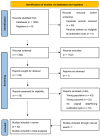Prevalence and Correlates of the Concurrence of Autism Spectrum Disorder and Obsessive Compulsive Disorder in Children and Adolescents: A Systematic Review and Meta-Analysis
- PMID: 38672028
- PMCID: PMC11048346
- DOI: 10.3390/brainsci14040379
Prevalence and Correlates of the Concurrence of Autism Spectrum Disorder and Obsessive Compulsive Disorder in Children and Adolescents: A Systematic Review and Meta-Analysis
Abstract
Background: Autism spectrum disorder (ASD) and obsessive compulsive disorder (OCD) are two common and impairing neurodevelopmental conditions with partial symptomatic overlap. The aim of this study is to systematically and meta-analytically examine the following: (i) the prevalence of an OCD diagnosis among young people with ASD, (ii) the prevalence of an ASD diagnosis among young people with OCD, and (iii) the clinical and therapeutic implications of such comorbidity.
Method: A multistep literature search was performed from database inception until 17 November 2023. This PRISMA/MOOSE-compliant systematic review, registered in PROSPERO (CRD42023480543), identified studies reporting on the prevalence, sociodemographic, psychopathologic, prognostic, and therapeutic correlates of OCD and ASD concurrence in children and adolescents. A quantitative meta-analysis with random effects was conducted to analyse the pooled prevalence of OCD among samples with a mean age of < 18 years old with ASD and the prevalence of ASD among individuals under 18 with OCD. Sensitivity analyses were performed to investigate the effect of diagnostic criteria and different continents. Meta-regression analyses were conducted to examine the effect of gender, age, IQ, and OCD severity scores. A narrative review of the clinical and therapeutical implications of the comorbidity was provided.
Results: 42 studies were selected for the systematic review (SR), and 31 of them were also included in one of the meta-analyses. The pooled prevalence of OCD among ASD youth samples (n = 8916, mean age = 10.6 ± 1.6; 16.4% female) was 11.6% (95% confidence intervals [CI] = 6.9%; 18.8%), and the pooled prevalence of ASD among OCD children and adolescent samples (n = 6209, mean age = 14.1 ± 1.4; 45.7% female) was 9.5% (95% CI = 6.0%; 14.7%). Meta-regressions found a statistically higher prevalence of ASD among samples with a lower prevalence of females (β = -4.7; 95%CI = -8.6; -0.8). Children with both OCD and ASD present higher rates of functional impairment, psychopathology, and other comorbidities, compared to youth with either of the disorders alone.
Conclusions: OCD and ASD are highly concurrent conditions in youth, with symptomatic, prognostic, severity, and therapeutic implications. Future research should focus on conducting longitudinal cohort studies prospectively to determine development trajectories, along with randomized controlled trials to assess the efficacy of specific therapeutic interventions.
Keywords: autism spectrum disorder; comorbidity; compulsion; obsessive compulsive disorder; ritual.
Conflict of interest statement
C.A. received personal fees or grants from Janssen Cilag and Neuraxpharm outside the current work. G.S.d.P. received honoraria from Janssen Cilag, Lundbeck, Angelini and Menarin outside this work.
Figures



Similar articles
-
Co-occurring obsessive-compulsive disorder and autism spectrum disorder in young people: prevalence, clinical characteristics and outcomes.Eur Child Adolesc Psychiatry. 2020 Nov;29(11):1603-1611. doi: 10.1007/s00787-020-01478-8. Epub 2020 Feb 1. Eur Child Adolesc Psychiatry. 2020. PMID: 32008168 Free PMC article.
-
Subclinical autism spectrum symptoms in pediatric obsessive-compulsive disorder.Eur Child Adolesc Psychiatry. 2016 Jul;25(7):711-23. doi: 10.1007/s00787-015-0782-5. Epub 2015 Oct 30. Eur Child Adolesc Psychiatry. 2016. PMID: 26518580
-
Examining clinical correlates, treatment outcomes and mediators in young people with comorbid obsessive-compulsive disorder and autism spectrum disorder.Eur Child Adolesc Psychiatry. 2023 Jul;32(7):1201-1210. doi: 10.1007/s00787-021-01921-4. Epub 2021 Dec 16. Eur Child Adolesc Psychiatry. 2023. PMID: 34914003 Free PMC article.
-
Comorbidities in Obsessive-Compulsive Disorder Across the Lifespan: A Systematic Review and Meta-Analysis.Front Psychiatry. 2021 Nov 11;12:703701. doi: 10.3389/fpsyt.2021.703701. eCollection 2021. Front Psychiatry. 2021. PMID: 34858219 Free PMC article.
-
Comorbidity of obsessive-compulsive disorder in bipolar spectrum disorders: Systematic review and meta-analysis of its prevalence.J Affect Disord. 2020 Feb 15;263:193-208. doi: 10.1016/j.jad.2019.11.136. Epub 2019 Dec 2. J Affect Disord. 2020. PMID: 31818777
Cited by
-
Psychotic vulnerability in pediatric obsessive-compulsive disorder: associations with clinical features and treatment outcome in two clinical samples.Eur Child Adolesc Psychiatry. 2025 May 30. doi: 10.1007/s00787-025-02757-y. Online ahead of print. Eur Child Adolesc Psychiatry. 2025. PMID: 40445237
-
Autism, menstruation and mental health- a scoping review and a call to action.Front Glob Womens Health. 2025 Jun 25;6:1531934. doi: 10.3389/fgwh.2025.1531934. eCollection 2025. Front Glob Womens Health. 2025. PMID: 40635787 Free PMC article.
-
Systematic Review: Convergence and Divergence Between Autism Spectrum Disorder and Obsessive-Compulsive Disorder: Genetic, Neuroimaging, and Cognitive Findings.J Am Acad Child Adolesc Psychiatry. 2025 Jun 25:S0890-8567(25)00312-0. doi: 10.1016/j.jaac.2025.06.017. Online ahead of print. J Am Acad Child Adolesc Psychiatry. 2025. PMID: 40578755 Review.
-
An evaluation of the psychometric properties of the social communication questionnaire in young people with obsessive-compulsive disorder.Clin Child Psychol Psychiatry. 2025 Jul;30(3):783-799. doi: 10.1177/13591045251344408. Epub 2025 May 21. Clin Child Psychol Psychiatry. 2025. PMID: 40398896 Free PMC article.
-
Clinical characteristics of obsessive-compulsive disorder comorbid with obsessive -compulsive personality disorder: subtype implications.Front Psychiatry. 2025 Jul 14;16:1577042. doi: 10.3389/fpsyt.2025.1577042. eCollection 2025. Front Psychiatry. 2025. PMID: 40727850 Free PMC article.
References
-
- . Diagnostic and Statistical Manual of Mental Disorders. American Psychiatric Association Publishing; Washington, DC, USA: 2022.
-
- Hossain M.M., Khan N., Sultana A., Ma P., McKyer E., Ahmed H.U., Purohit N. Prevalence of comorbid psychiatric disorders among people with autism spectrum disorder: An umbrella review of systematic reviews and meta-analyses. Psychiatry Res. 2020;287:112922. doi: 10.1016/j.psychres.2020.112922. - DOI - PubMed
Publication types
LinkOut - more resources
Full Text Sources
Research Materials

